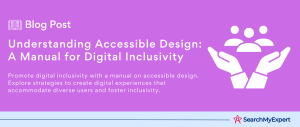Mobile-First Design: Embracing the Age of Smartphones
In today’s digital era, where smartphones have become an extension of ourselves, the concept of Mobile-First Design has emerged as a cornerstone in the world of web development and design. This approach fundamentally shifts the traditional design process by prioritizing mobile devices, which are often constrained by smaller screens and different user interaction methods compared to desktop computers.
Understanding the Core of Mobile-First Design
At its heart, Mobile-First Design is an approach where designers and developers start crafting a website or application for mobile devices first, rather than making it for desktops and then trying to shrink it down for smaller screens. This method ensures that the most essential elements of your site or app are thoughtfully considered for the mobile experience from the get-go.
Why Mobile-First Design is More Relevant Than Ever
- Surging Mobile Usage: Statistics show a continuous surge in mobile device usage globally. More people are accessing the internet via smartphones than ever before, making mobile web browsing not just a trend, but a staple.
- User Experience is King:
Mobile users expect quick, accessible, and seamless experiences. Websites and applications not optimized for mobile often suffer from poor user engagement and higher bounce rates. - Google’s Mobile-First Indexing: Google has shifted to mobile-first indexing for all websites, meaning the mobile version of your website is now the benchmark for how Google evaluates and ranks your site.
Advantages of Mobile-First Design: Expanding Horizons and Streamlining Experiences
Mobile-first design, by its very nature, brings a multitude of benefits, not only enhancing user experience but also providing practical advantages for businesses and developers. Let’s explore the key advantages of adopting this forward-thinking approach.
Unmatched Accessibility and Reach
- Wider Audience Engagement:
By focusing on mobile users first, businesses tap into a larger demographic. This includes users who primarily rely on smartphones for internet access, particularly in regions where desktop computers are less common. - Inclusivity for Varied Devices:
Mobile-first designs cater to a range of devices, from the latest smartphones to older models, ensuring your content is accessible to users with diverse technology access. - Optimization for Limited Data Plans: These designs are often data-efficient, a critical factor for users on restricted data plans, ensuring that your website or application is not just accessible but also considerate of users’ data limitations.
Enhanced Content Prioritization
- Focus on Core Content:
This approach compels designers to concentrate on the most crucial information and functionality, leading to a cleaner, more focused user experience. - Elimination of Unnecessary Elements: By stripping away non-essential elements, users are presented with a straightforward, direct interface, enhancing usability and engagement.
Improved Performance and Efficiency
- Speedy Loading Times: Lightweight designs are a staple of the mobile-first approach, leading to faster loading times which are crucial for retaining mobile users who often have lower patience for slow websites.
- Efficient Use of Mobile Networks: These designs are optimized for mobile networks, ensuring smoother performance even in areas with slower internet speeds.
Streamlined Development Optimization
- Simplified Design Process:
Starting with mobile simplifies the design process. Once the mobile version is perfected, scaling up to larger screens is often more straightforward than scaling down. - Consistency Across Platforms: This approach ensures a consistent and coherent user experience across various devices and platforms, building a stronger brand identity and user trust.
Key Principles of Mobile-First Design: Crafting User-Centric, Responsive Digital Experiences
Mobile-First Design isn’t just about making things smaller or faster; it’s a philosophy that encompasses several principles aimed at creating an optimal mobile user experience. Understanding and implementing these principles is crucial for any designer or developer looking to thrive in the mobile-dominated digital landscape.
User-Centered Approach: Understanding the Mobile User
- Empathy for User Needs: At the core of Mobile-First Design is a deep understanding of the mobile user’s needs, preferences, and challenges. This means considering factors like context of use (e.g., on the go), connectivity issues, and screen size limitations.
- Contextual User Experience:
Designing for mobile requires an appreciation of the user’s environment. Mobile users are often multitasking or seeking quick information, which necessitates a design that caters to these specific contexts.
Prioritization and Clarity: Streamlining Your Content
- Content Hierarchy:
Prioritizing content means determining what is most important for the user to see first. This approach helps in creating a clear path for users to follow, enhancing the overall user journey on a small screen. - Clarity and Conciseness:
With limited screen space, every pixel counts. The mobile-first design calls for clear, concise content and design elements, removing anything that doesn’t serve a direct purpose.
Thumb-Friendly Interactions: Designing for Touch
- Optimized for Touch Input:
Unlike desktops, mobile devices are primarily touch-based. Design elements such as buttons, links, and gestures must be easily accessible and usable with a thumb. - Ergonomic Considerations:
The design should account for how users hold and interact with their devices, ensuring that key interactive elements are within easy reach of the thumb.
Responsive Layouts: Flexibility Across Devices
- Adaptable to Various Screen Sizes:
A fundamental aspect of Mobile-First Design is creating layouts that fluidly adapt to different screen sizes and orientations, from small smartphones to large tablets. - Fluid Grids and Flexible Elements:
Using fluid grid layouts and flexible images/videos ensures that your design looks and functions effectively across all devices, providing a consistent user experience.
Implementing Mobile-First Design Workflow: A Step-by-Step Guide
Adopting a Mobile-First Design approach involves a strategic workflow that ensures your digital product is optimized for mobile users from the outset. This process involves several key stages, from initial wireframing to continuous testing and iteration.
Wireframing and Prototyping: Laying the Foundation
- Starting with Low-Fidelity Prototypes:
Begin by sketching low-fidelity wireframes for mobile screens. This early-stage visualization helps identify key elements and layout without getting bogged down in details. - Benefits of Mobile-First Prototypes:
This approach ensures that the core functionality and user experience are tailored for mobile users first, which can then be scaled up to larger screens, rather than the other way around.
Content Hierarchy and Prioritization: Organizing for Impact
- Techniques for Prioritizing Content:
In a mobile-first approach, content must be arranged based on its importance to the user. Techniques like card sorting can help determine which content users find most valuable. - Optimizing Information Architecture:
Develop an information architecture that is intuitive and easy to navigate on a small screen. This might mean simplifying menus or breaking up content into more digestible chunks for the mobile format.
Visual Design Considerations: Crafting a Responsive Aesthetic
- Using Legible Fonts:
Choose fonts that are easy to read on small screens. Legibility is key, so opt for simple, clean font styles and appropriate sizes. - Appropriate Graphics: Use graphics and images judiciously, ensuring they are optimized for mobile and do not hinder page loading times.
- Touch-Friendly UI Elements: Design buttons, links, and other interactive elements to be easily tapped with a finger. This means making them large enough to be clicked without zooming and spaced out to prevent accidental taps.
Testing and Iteration: Refining for Perfection
- Regular Testing on Mobile Devices: Continuously test your design on actual mobile devices to understand how it performs in real-world usage. This includes checking compatibility across different screen sizes and operating systems.
- Iterating Based on User Feedback:
Collect and analyze user feedback. Iterative design means making adjustments based on this feedback to continuously improve the mobile experience.
Mobile-First Design vs. Desktop-First Approach: Adapting to Digital Evolution
In the realm of web design and development, two predominant methodologies have emerged: Mobile-First Design and Desktop-First Approach. While both aim to create engaging and functional digital experiences, their starting points and strategies differ significantly. Understanding these differences is key to choosing the right approach for your project.
Mobile-First Design: Embracing Mobile Constraints as Opportunities
- Starting with Limitations:
Mobile-First Design begins by embracing the limitations of smaller screens, less powerful processors, and variable internet connectivity. This constraint-based approach forces designers to focus on the essentials, leading to a more streamlined and user-focused product. - Scalability to Larger Screens:
When a design is optimized for mobile, scaling up to larger screens (like desktops) is often more straightforward. The core functionality and content are already prioritized, so the transition to a larger canvas involves enhancing and expanding rather than reducing and reorganizing.
Desktop-First Approach: The Traditional Route
- Beginning with Abundance:
The Desktop-First Approach starts with the assumption of larger screens and more robust hardware. This allows for more complex designs and functionalities from the outset. - Challenges in Scaling Down:
When a design created for a desktop needs to be adapted for mobile, it often faces significant challenges. Complex layouts, hover states not suitable for touchscreens, and heavier graphics can lead to a compromised mobile user experience.
Comparing the Two Approaches
- The benefit of Mobile-First in the Modern Era: With the increasing dominance of mobile internet usage, the Mobile-First Design approach aligns more closely with the current user behavior patterns. By prioritizing mobile, designers ensure that their websites or applications are accessible to the widest possible audience from the start.
- Desktop-First May Face Obsolescence Risks:
As mobile usage continues to rise, the Desktop-First Approach risks becoming less relevant. Designs that don’t translate well to mobile can alienate a large segment of users and suffer from reduced engagement and effectiveness.
Essential Tools and Resources for Effective Mobile-First Design
To successfully implement a Mobile-First Design approach, having the right set of tools and resources is crucial. These tools not only facilitate the design and development process but also provide valuable insights and inspiration. Let’s explore some of the key tools and resources that are indispensable in the realm of mobile-first design.
Prototyping and Wireframing Tools
- Adobe XD:
A powerful tool for designing and prototyping user experiences for web and mobile apps. Adobe XD offers collaborative features and an array of design assets. - Sketch:
Known for its simplicity and extensive plugin ecosystem, Sketch is a favorite among designers for creating high-fidelity interfaces and prototypes. - Figma:
An increasingly popular tool that combines design, prototyping, and collaboration features. Its cloud-based approach allows for real-time collaboration. - InVision: Offers robust prototyping capabilities, allowing designers to create interactive mockups and receive immediate feedback.
Testing Tools for Mobile Designs
- BrowserStack:
Enables testing of mobile websites on various mobile devices and browsers, ensuring compatibility and responsiveness. - Google Mobile-Friendly Test:
A quick way to test if a webpage is mobile-friendly, this tool also provides insights into areas of improvement. - Responsive Design Checker:
A handy tool for checking how your design looks across different devices and screen sizes.
Design Guidelines and Best Practices
- Google’s Material Design:
A comprehensive design system that provides guidelines, components, and tools for creating intuitive and engaging user interfaces. - Apple’s Human Interface Guidelines:
Offers detailed guidelines for designing for iOS, focusing on usability and the aesthetic aspects of mobile design.
Inspiration and Case Studies
- Behance and Dribble:
These platforms are great for finding inspiration, and showcasing creative mobile design projects from designers worldwide. - UX Design Case Studies:
Many websites and blogs publish in-depth case studies on successful mobile-first design projects, providing valuable insights and real-world examples.
Online Courses and Tutorials
- Coursera and Udemy: Offer courses on mobile UI/UX design, where beginners can learn the fundamentals and experienced designers can hone their skills.
- YouTube Channels:
Channels dedicated to UI/UX design can be a great resource for learning new tips and tricks in mobile-first design.
Embracing the Future with Mobile-First Design: Key Takeaways and a Call to Action
As we conclude our comprehensive exploration of Mobile-First Design, it’s important to reflect on the significant benefits and insights this approach brings to the digital landscape. Let’s summarize the key takeaways and encourage a forward-thinking action plan.
Key Takeaways of Mobile-First Design
- Prioritizing User Experience:
Mobile-first design places the user at the forefront, ensuring that the most essential elements of your digital product are optimized for the vast majority of internet users today – mobile users. - Enhanced Accessibility and Reach:
This approach allows you to cater to a broader audience, including those with limited data plans or older devices, ensuring inclusivity and wider reach. - Streamlined Content and Performance:
By focusing on prioritizing content and maintaining clarity, Mobile-First Design leads to faster loading times and more efficient performance on mobile networks. - Adaptability Across Devices:
Starting with mobile constraints encourages designs that are naturally more adaptable to various screen sizes, making the transition to larger screens more seamless. - Improved Rankings and Online Visibility:
With search engines like Google adopting mobile-first indexing, this approach is crucial for better search engine rankings and online visibility.
A Call to Action: Implement Mobile-First in Your Projects
With the undeniable benefits and strategic advantages that Mobile-First Design offers, it’s clear that embracing this approach is not just a trend but a necessity in the current digital era. Whether you are a web designer, developer, business owner, or marketer, considering a mobile-first approach in your digital projects is pivotal.
- Start with User-Centered Design:
Begin your projects by understanding and prioritizing the needs of mobile users. - Utilize the Right Tools:
Leverage the tools and resources available for prototyping, wireframing, and testing to ensure your designs are optimized for mobile. - Stay Informed and Inspired:
Keep up with the latest trends, guidelines, and case studies in mobile-first design to continuously improve and innovate. - Test and Iterate:
Emphasize regular testing and be ready to iterate based on user feedback to refine the mobile experience.
Conclusion:
Mobile-First Design represents more than just a design strategy; it’s a critical approach in today’s increasingly mobile-centric world. This guide has walked you through the essential aspects of Mobile-First Design, from understanding its fundamental principles to implementing effective design workflows. By adopting this approach, you’ll ensure your digital projects are not only visually appealing but also functionally optimized for the vast array of mobile devices used by consumers today.
Remember, in the digital age, a mobile-first mindset is key to creating impactful and engaging user experiences. Start integrating these practices into your projects and stay ahead in the dynamic world of web and app design.
Stand out in the digital world with our Digital Design Firms.
Table of Contents
Toggle






